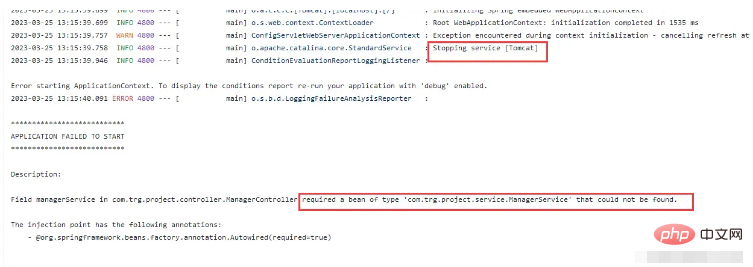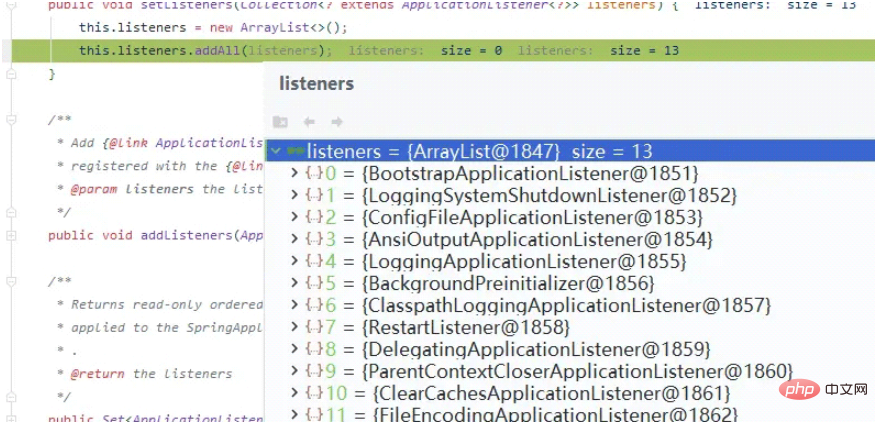SpringBoot启动原理是什么
入口
版本: 2.1.8.RELEASE
启动代码:
@SpringBootApplcation
public static void main(String[] args) {
SpringApplication.run(BlogAdminApplication.class, args);
System.out.println("======== admin start success... ==========");
}这里传入了两个参数,BlogAdminApplication当前类和args参数
我们点击进入run方法查看
public static ConfigurableApplicationContext run(Class<?> primarySource, String... args) {
return run(new Class[]{primarySource}, args);
}这里是将我们写的启动类传入到了Class[]数组中,这步就是个单纯的参数转换。
探讨primarySource参数
那么问题是primarySource能接受的类型是啥样的,是不是什么类都可以接受,带着这个疑问,我们做一个测试,把这个参数给换成一个别的类呢,ManagerController类是一个我写的接口类
@SpringBootApplication
public class BlogProjectApplication {
public static void main(String[] args) {
SpringApplication.run(ManagerController.class, args);
System.out.println("======== admin start success... ==========");
}
}控制台打印
org.springframework.context.ApplicationContextException: Unable to start web server; nested exception is org.springframework.context.ApplicationContextException: Unable to start ServletWebServerApplicationContext due to missing ServletWebServerFactory bean.
提示不能启动服务,提示缺少了ServletWebServerFactory bean 点进这个类看下
@FunctionalInterface
public interface ServletWebServerFactory {
WebServer getWebServer(ServletContextInitializer... initializers);
}他被FunctionalInterface标注了,是一个函数式接口,只有一个getWebServer方法,用来获取webServer的 看下他的实现类,

这不就是提示我们缺少启动的服务容器么,说的直白点,我的理解就是他缺少可以运行的容器,我们知道,没有使用springboot项目之前,我们的项目都是跑在tomcat容器上的,当然也有使用Jetty容器的。再者,我们知道SpringBoot是对tomcat进行了内置。而SpringBoot不仅仅是只有内置了tomcat,而且还内置了好多的东西,比如我们经常使用的mq、redis等等一系列的东西,这个我们可以在spring.factories配置文件中看到,这个文件位于如下位置

大概内容有下,篇幅有限,就不一一列举了。
省略。。。 org.springframework.boot.autoconfigure.EnableAutoConfiguration=\ org.springframework.boot.autoconfigure.admin.SpringApplicationAdminJmxAutoConfiguration,\ org.springframework.boot.autoconfigure.aop.AopAutoConfiguration,\ org.springframework.boot.autoconfigure.amqp.RabbitAutoConfiguration,\ org.springframework.boot.autoconfigure.batch.BatchAutoConfiguration,\ org.springframework.boot.autoconfigure.cache.CacheAutoConfiguration,\ 省略。。。
那么回过头来,我们再看下这个问题,这些个类是如何被加载进来的,我们知道SpingBoot有个注解是开启自动注解的@EnableAutoConfiguration,他就干这个事情的。他能够激活SpringBoot内建和自定义组件的自动装配特性。
那么,知道了这些,我们把这个之前修改后的类给改造一下,加上注解@EnableAutoConfiguration,看下执行效果。
@RestController
@RequestMapping("project/manager")
@EnableAutoConfiguration
public class ManagerController extends AbstractController {运行如下

从打印信息就能知道,服务器有了,只不过下面报错,提示找不到bean,那这不就简单了么,他是不是就是没有扫描到我们的包么,这里就其实可以在配置扫描包的注解继续测试,我就懒的不测试了,直接去看@SpringBootApplication注解
@Target({ElementType.TYPE})
@Retention(RetentionPolicy.RUNTIME)
@Documented
@Inherited
@SpringBootConfiguration
@EnableAutoConfiguration
//
@ComponentScan(
excludeFilters = {@Filter(
type = FilterType.CUSTOM,
classes = {TypeExcludeFilter.class}
), @Filter(
type = FilterType.CUSTOM,
classes = {AutoConfigurationExcludeFilter.class}
)}
)
public @interface SpringBootApplication {@SpringBootApplication这个注解其实就是一个组合注解,里面包含了
元注解:用来标注他是一个注解的,jdk自带的
@SpringBootConfiguration:集成自@Configuration,表示是一个配置类
@EnableAutoConfiguration:激活SpringBoot内建和自定义组件的自动装配特性
@ComponentScan:扫描注解,添加了排除参数,指定排除了一些类
通过这里的实验,我们可以得出结论:
primarySource参数能接收的类是一个配置类,同时要把符合扫描规则的类装配到spring容器中,并且对SpringBoot内置的一些类进行自动扫描到,而这里的@SpringBootApplication注解就是把这些特性都整合到了一起,作为了一个引导类而已。那么说白了,primarySource他接受的其实就是一个配置类。
关于注解详细知识的话,这里就聊这么多了,后面再详细聊。
args参数
args是Java命令行参数,我们在DOS中执行Java程序的时候使用“java 文件名 args参数”。args这个数组可以接收到这些参数。这个是个基础常识了。
以下我们将继续跟踪源码进行分析
我们继续追run()方法
public static ConfigurableApplicationContext run(Class<?>[] primarySources, String[] args) {
return (new SpringApplication(primarySources)).run(args);
}这个方法干了两个事情:
1、new SpringApplication()来创建对象
2、通过创建后的对象,调用对象里面的run()方法
以下我们将从这两个地方进行分析,本篇就先研究第一个
创建对象
我们先看下他是怎么创建对象的,创建了哪些对象,
public SpringApplication(Class<?>... primarySources) {
this((ResourceLoader)null, primarySources);
}
public SpringApplication(ResourceLoader resourceLoader, Class<?>... primarySources) {
//资源加载器
this.resourceLoader = resourceLoader;
//断言
Assert.notNull(primarySources, "PrimarySources must not be null");
//对primarySources进行存储到LinkedHashSet
this.primarySources = new LinkedHashSet<>(Arrays.asList(primarySources));
//1、推断web应用类别
this.webApplicationType = WebApplicationType.deduceFromClasspath();
//2、加载Spring应用上下文初始化
setInitializers((Collection) getSpringFactoriesInstances(ApplicationContextInitializer.class));
//3、加载Spring应用事件监听器
setListeners((Collection) getSpringFactoriesInstances(ApplicationListener.class));
//4、推断应用引导类
this.mainApplicationClass = deduceMainApplicationClass();
}下面研究下主要流程部分
1、推断web应用类别
推断web应用类型属于SpringBoot应用web类型的初始化过程。而该类型也可在SpringApplication构造后,run方法执行之前,通过setWebApplicationType(WebApplicationType webApplicationType)方法进行调整。
在推断Web应用类型的过程中,由于当前Spring应用上下文尚未准备(可在代码执行顺序中看到),所以实现采用的是检查检查当前ClassLoader下基准Class的存在性判断。
上源码
this.webApplicationType = WebApplicationType.deduceFromClasspath();
private static final String[] SERVLET_INDICATOR_CLASSES = { "javax.servlet.Servlet",
"org.springframework.web.context.ConfigurableWebApplicationContext" };
private static final String WEBMVC_INDICATOR_CLASS = "org.springframework." + "web.servlet.DispatcherServlet";
private static final String WEBFLUX_INDICATOR_CLASS = "org." + "springframework.web.reactive.DispatcherHandler";
private static final String JERSEY_INDICATOR_CLASS = "org.glassfish.jersey.servlet.ServletContainer";
private static final String SERVLET_APPLICATION_CONTEXT_CLASS = "org.springframework.web.context.WebApplicationContext";
private static final String REACTIVE_APPLICATION_CONTEXT_CLASS = "org.springframework.boot.web.reactive.context.ReactiveWebApplicationContext";
static WebApplicationType deduceFromClasspath() {
//当DispatcherHandler存在,且DispatcherServlet、ServletContainer两个不存在时;换言之,SpringBoot仅依赖WebFlux存在时,此时的应用类型为REACTIVE
if (ClassUtils.isPresent(WEBFLUX_INDICATOR_CLASS, null) && !ClassUtils.isPresent(WEBMVC_INDICATOR_CLASS, null)
&& !ClassUtils.isPresent(JERSEY_INDICATOR_CLASS, null)) {
return WebApplicationType.REACTIVE;
}
//当Servlet和ConfigurableWebApplicationContext均不存在时,当前应用为非Web应用,即WebApplicationType.NONE,因为这些API均是Spring Web MVC必须的依赖
for (String className : SERVLET_INDICATOR_CLASSES) {
if (!ClassUtils.isPresent(className, null)) {
return WebApplicationType.NONE;
}
}
//当WebFlux和Spring Web MVC同时存在时,Web应用类型同样是Servlet Web,即WebApplicationType.SERVLET
return WebApplicationType.SERVLET;
}2、加载Spring应用上下文初始化
setInitializers((Collection) getSpringFactoriesInstances(ApplicationContextInitializer.class));
此过程包含两个动作,依次为getSpringFactoriesInstances(ApplicationContextInitializer.class)和setInitializers方法。 先看第一个过程
private <T> Collection<T> getSpringFactoriesInstances(Class<T> type) {
return getSpringFactoriesInstances(type, new Class<?>[] {});
}
private <T> Collection<T> getSpringFactoriesInstances(Class<T> type, Class<?>[] parameterTypes, Object... args) {
//获取类加载器
ClassLoader classLoader = getClassLoader();
// Use names and ensure unique to protect against duplicates
//加载了META-INF/spring.factories资源中配置的ApplicationContextInitializer实现类名单。
Set<String> names = new LinkedHashSet<>(SpringFactoriesLoader.loadFactoryNames(type, classLoader));
//初始化
List<T> instances = createSpringFactoriesInstances(type, parameterTypes, classLoader, args, names);
AnnotationAwareOrderComparator.sort(instances);
return instances;
}此处使用了Spring工厂加载机制方法SpringFactoriesLoader.loadFactoryNames(type, classLoader)。加载了META-INF/spring.factories资源中配置的ApplicationContextInitializer实现类名单。

加载完成后使用createSpringFactoriesInstances方法对其进行初始化。
private <T> List<T> createSpringFactoriesInstances(Class<T> type, Class<?>[] parameterTypes,
ClassLoader classLoader, Object[] args, Set<String> names) {
List<T> instances = new ArrayList<>(names.size());
for (String name : names) {
try {
//从类加载器中获取指定类
Class<?> instanceClass = ClassUtils.forName(name, classLoader);
//判断instanceClass是不是type的子类
Assert.isAssignable(type, instanceClass);
//根据以上获取的类名创建类的实例
Constructor<?> constructor = instanceClass.getDeclaredConstructor(parameterTypes);
//排序
T instance = (T) BeanUtils.instantiateClass(constructor, args);
instances.add(instance);
}
catch (Throwable ex) {
throw new IllegalArgumentException("Cannot instantiate " + type + " : " + name, ex);
}
}
return instances;
}3、加载Spring应用事件监听器
setListeners((Collection) getSpringFactoriesInstances(ApplicationListener.class));
此过程与2、加载上下文初始化基本类似。 只不过初始化的对象类型变成了ApplicationListener.class,setListeners方法也只是赋值而已
public void setListeners(Collection<? extends ApplicationListener<?>> listeners) {
this.listeners = new ArrayList<>();
this.listeners.addAll(listeners);
}
4、推断应用引导类
this.mainApplicationClass = deduceMainApplicationClass();
private Class<?> deduceMainApplicationClass() {
try {
StackTraceElement[] stackTrace = new RuntimeException().getStackTrace();
for (StackTraceElement stackTraceElement : stackTrace) {
if ("main".equals(stackTraceElement.getMethodName())) {
return Class.forName(stackTraceElement.getClassName());
}
}
}
catch (ClassNotFoundException ex) {
// Swallow and continue
}
return null;
}这里使用到了new RuntimeException().getStackTrace()来获取堆栈信息,找到调用执行的main方法,从而确定他的类。
这里有个疑问:他不是传了primarySources数组,里面包含了类名么,怎么还用堆栈的方式去获取,此外,这里的堆栈获取也只能获取一个调用的主main方法,他为啥还要传一个Class数组呢?
具体咋获取的,可以追下源码,一直跟踪他的父类Throwable,找到如下代码
/**
* Fills in the execution stack trace. This method records within this
* {@code Throwable} object information about the current state of
* the stack frames for the current thread.
*
* <p>If the stack trace of this {@code Throwable} {@linkplain
* Throwable#Throwable(String, Throwable, boolean, boolean) is not
* writable}, calling this method has no effect.
*
* @return a reference to this {@code Throwable} instance.
* @see java.lang.Throwable#printStackTrace()
*/
public synchronized Throwable fillInStackTrace() {
if (stackTrace != null ||
backtrace != null /* Out of protocol state */ ) {
fillInStackTrace(0);
stackTrace = UNASSIGNED_STACK;
}
return this;
}
private native Throwable fillInStackTrace(int dummy);这里最后调用了native本地方法,去爬取线程堆栈信息,为运行时栈做一份快照。

通过这个图片,可以看到整个方法的调用链,从下往上看哦
以上是SpringBoot启动原理是什么的详细内容。更多信息请关注PHP中文网其他相关文章!

热AI工具

Undresser.AI Undress
人工智能驱动的应用程序,用于创建逼真的裸体照片

AI Clothes Remover
用于从照片中去除衣服的在线人工智能工具。

Undress AI Tool
免费脱衣服图片

Clothoff.io
AI脱衣机

AI Hentai Generator
免费生成ai无尽的。

热门文章

热工具

记事本++7.3.1
好用且免费的代码编辑器

SublimeText3汉化版
中文版,非常好用

禅工作室 13.0.1
功能强大的PHP集成开发环境

Dreamweaver CS6
视觉化网页开发工具

SublimeText3 Mac版
神级代码编辑软件(SublimeText3)

热门话题
 Springboot怎么集成Jasypt实现配置文件加密
Jun 01, 2023 am 08:55 AM
Springboot怎么集成Jasypt实现配置文件加密
Jun 01, 2023 am 08:55 AM
Jasypt介绍Jasypt是一个java库,它允许开发员以最少的努力为他/她的项目添加基本的加密功能,并且不需要对加密工作原理有深入的了解用于单向和双向加密的高安全性、基于标准的加密技术。加密密码,文本,数字,二进制文件...适合集成到基于Spring的应用程序中,开放API,用于任何JCE提供程序...添加如下依赖:com.github.ulisesbocchiojasypt-spring-boot-starter2.1.1Jasypt好处保护我们的系统安全,即使代码泄露,也可以保证数据源的
 SpringBoot怎么集成Redisson实现延迟队列
May 30, 2023 pm 02:40 PM
SpringBoot怎么集成Redisson实现延迟队列
May 30, 2023 pm 02:40 PM
使用场景1、下单成功,30分钟未支付。支付超时,自动取消订单2、订单签收,签收后7天未进行评价。订单超时未评价,系统默认好评3、下单成功,商家5分钟未接单,订单取消4、配送超时,推送短信提醒……对于延时比较长的场景、实时性不高的场景,我们可以采用任务调度的方式定时轮询处理。如:xxl-job今天我们采
 怎么在SpringBoot中使用Redis实现分布式锁
Jun 03, 2023 am 08:16 AM
怎么在SpringBoot中使用Redis实现分布式锁
Jun 03, 2023 am 08:16 AM
一、Redis实现分布式锁原理为什么需要分布式锁在聊分布式锁之前,有必要先解释一下,为什么需要分布式锁。与分布式锁相对就的是单机锁,我们在写多线程程序时,避免同时操作一个共享变量产生数据问题,通常会使用一把锁来互斥以保证共享变量的正确性,其使用范围是在同一个进程中。如果换做是多个进程,需要同时操作一个共享资源,如何互斥呢?现在的业务应用通常是微服务架构,这也意味着一个应用会部署多个进程,多个进程如果需要修改MySQL中的同一行记录,为了避免操作乱序导致脏数据,此时就需要引入分布式锁了。想要实现分
 springboot读取文件打成jar包后访问不到怎么解决
Jun 03, 2023 pm 04:38 PM
springboot读取文件打成jar包后访问不到怎么解决
Jun 03, 2023 pm 04:38 PM
springboot读取文件,打成jar包后访问不到最新开发出现一种情况,springboot打成jar包后读取不到文件,原因是打包之后,文件的虚拟路径是无效的,只能通过流去读取。文件在resources下publicvoidtest(){Listnames=newArrayList();InputStreamReaderread=null;try{ClassPathResourceresource=newClassPathResource("name.txt");Input
 Springboot+Mybatis-plus不使用SQL语句进行多表添加怎么实现
Jun 02, 2023 am 11:07 AM
Springboot+Mybatis-plus不使用SQL语句进行多表添加怎么实现
Jun 02, 2023 am 11:07 AM
在Springboot+Mybatis-plus不使用SQL语句进行多表添加操作我所遇到的问题准备工作在测试环境下模拟思维分解一下:创建出一个带有参数的BrandDTO对象模拟对后台传递参数我所遇到的问题我们都知道,在我们使用Mybatis-plus中进行多表操作是极其困难的,如果你不使用Mybatis-plus-join这一类的工具,你只能去配置对应的Mapper.xml文件,配置又臭又长的ResultMap,然后再去写对应的sql语句,这种方法虽然看上去很麻烦,但具有很高的灵活性,可以让我们
 SpringBoot与SpringMVC的比较及差别分析
Dec 29, 2023 am 11:02 AM
SpringBoot与SpringMVC的比较及差别分析
Dec 29, 2023 am 11:02 AM
SpringBoot和SpringMVC都是Java开发中常用的框架,但它们之间有一些明显的差异。本文将探究这两个框架的特点和用途,并对它们的差异进行比较。首先,我们来了解一下SpringBoot。SpringBoot是由Pivotal团队开发的,它旨在简化基于Spring框架的应用程序的创建和部署。它提供了一种快速、轻量级的方式来构建独立的、可执行
 SpringBoot怎么自定义Redis实现缓存序列化
Jun 03, 2023 am 11:32 AM
SpringBoot怎么自定义Redis实现缓存序列化
Jun 03, 2023 am 11:32 AM
1、自定义RedisTemplate1.1、RedisAPI默认序列化机制基于API的Redis缓存实现是使用RedisTemplate模板进行数据缓存操作的,这里打开RedisTemplate类,查看该类的源码信息publicclassRedisTemplateextendsRedisAccessorimplementsRedisOperations,BeanClassLoaderAware{//声明了key、value的各种序列化方式,初始值为空@NullableprivateRedisSe
 springboot怎么获取application.yml里值
Jun 03, 2023 pm 06:43 PM
springboot怎么获取application.yml里值
Jun 03, 2023 pm 06:43 PM
在项目中,很多时候需要用到一些配置信息,这些信息在测试环境和生产环境下可能会有不同的配置,后面根据实际业务情况有可能还需要再做修改。我们不能将这些配置在代码中写死,最好是写到配置文件中,比如可以把这些信息写到application.yml文件中。那么,怎么在代码里获取或者使用这个地址呢?有2个方法。方法一:我们可以通过@Value注解的${key}即可获取配置文件(application.yml)中和key对应的value值,这个方法适用于微服务比较少的情形方法二:在实际项目中,遇到业务繁琐,逻






